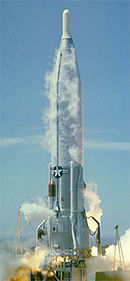 The CCB of Atlas V AV-021 is erected at the Vertical Integration Facility of SLC-41 ahead of the launch of the Solar Dynamics Observatory | |
| Manufacturer |
|
|---|---|
| Country of origin | United States |
| Used on | Atlas V |
| General characteristics | |
| Height | 32.46 m (106.5 ft) |
| Diameter | 3.81 m (12.5 ft) |
| Propellant mass | 284,089 kg (626,309 lb) |
| Empty mass |
|
| Propulsion | |
| Powered by | 1× RD-180 |
| Maximum thrust | 3,827 kN (860,000 lbf) (SL) 4,152 kN (933,000 lbf) (vac) |
| Burn time | 253 s |
| Propellant | LOX/RP-1 |
The Common Core Booster (CCB) is a rocket stage, which is used as the first stage of the American Atlas V rocket as part of its modular design. It was also intended that two additional CCBs would be used as boosters on the Atlas V Heavy, however this configuration has not been developed. Use of a Common Core Booster as the first stage of the Japanese GX was also planned; however, this program was cancelled in late 2009.
The Common Core Booster is 32.46 m (106.5 ft) long, has a diameter of 3.81 m (12.5 ft) and is powered by a single RD-180 engine burning RP-1 and liquid oxygen. [2] The CCB's fuel tanks are built out of isogrid aluminum. [3]
Testing of the CCB and its RD-180 engines was conducted in the United States at the Marshall Space Flight Center, and in Khimki, Russia. The test programme concluded with the final engine test in December 2001. [4] The first launch of a Common Core Booster was the maiden flight of the Atlas V, which was launched from Space Launch Complex 41 at the Cape Canaveral Air Force Station on 21 August 2002. [5] As of November 2020, the Atlas V has made 86 flights, all of which have used a single Common Core Booster. [6]
